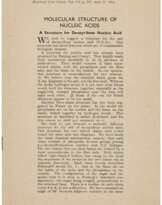ID 1032779
Lot 127 | The Structure of DNA
Estimate value
$ 3 000 – 5 000
The first presentation of the DNA double helix at an open meeting. Extremely rare offprint, Leonard Hamilton's copy. The Cold Spring Harbor Symposia on Quantitative Biology began in 1933 and from 1941 onwards, but particularly after this year, 1953, they became the most important gathering event for molecular geneticists. The Symposium (5-11 June) was just six weeks away when the first of Watson and Crick's papers appeared in Nature in late April and Watson's invitation to speak was last-minute indeed. "The [CSHL] Symposium achieved its mythic quality because of a last minute addition to the [1953] program. As [Max] Delbrück put it in his opening remarks, 'The discovery of a structure for DNA proposed by Watson and Crick a few months ago, and the obvious suggestions arising from this structure concerning replication seemed of such relevance to many of the questions to be discussed at this meeting...' that the work had to be included. So it was that Jim Watson—immortalized in the Symposium photographs, tall, gangly and wearing shorts—made the first presentation of the DNA double helix at an open meeting" (CSHL Library website).
Almost every scientist in the audience would have the course of their research profoundly altered by the discovery. Watson wrote about the experience of speaking at Cold Spring in June 1953, calling the occasion the "unveiling" of the double-helix (see Watson and Berry, DNA, pp.57-58). The introduction states: "In this paper we shall describe a structure for DNA which ... allows us to propose, for the first time, a detailed hypothesis on the atomic level for the self-reproduction of genetic material" and refers to the April and May Nature papers as the "preliminary account."
Quarto (272 x 194mm). 5 leaves, illustrated with 7 figures including two photographic ones. Stapled into printed covers. (Lower left corner folded with a few small tears to cover and first 2 leaves, some overall handling creases.) Provenance: Leonard D. Hamilton, 1921-2019 (ownership signature to front page).
| Artist: | Francis Crick (1916 - 2004) James Dewey Watson (1928) |
|---|---|
| Place of origin: | England, USA |
| Auction house category: | Printed books |
| Artist: | Francis Crick (1916 - 2004) James Dewey Watson (1928) |
|---|---|
| Place of origin: | England, USA |
| Auction house category: | Printed books |
| Address of auction |
CHRISTIE'S 20 Rockefeller Plaza 10020 New York USA | ||||||||||||||
|---|---|---|---|---|---|---|---|---|---|---|---|---|---|---|---|
| Preview |
| ||||||||||||||
| Phone | +1 212 636 2000 | ||||||||||||||
| Fax | +1 212 636 4930 | ||||||||||||||
| Conditions of purchase | Conditions of purchase | ||||||||||||||
| Shipping |
Postal service Courier service pickup by yourself | ||||||||||||||
| Payment methods |
Wire Transfer | ||||||||||||||
| Business hours | Business hours
|









